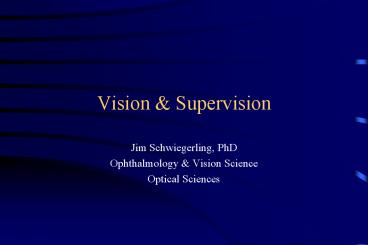Vision - PowerPoint PPT Presentation
1 / 38
Title:
Vision
Description:
Visual Acuity is a measure of the smallest targets we can resolve. ... Phakic IOLs. Excimer Laser - 193 nm. Excimer Laser. Photorefractive Keratectomy ... – PowerPoint PPT presentation
Number of Views:192
Avg rating:3.0/5.0
Title: Vision
1
Vision Supervision
- Jim Schwiegerling, PhD
- Ophthalmology Vision Science
- Optical Sciences
2
Introduction
- Visual Acuity is a measure of the smallest
targets we can resolve. - Acuity is typically limited by gross
(near-sightedness, far-sightedness and
astigmatism) and subtle (aberrations) defects in
the shape of the ocular surfaces. - Modern refractive surgeries seek to eliminate
both of these defects and improve visual acuity. - The natural question is How much can we improve
acuity?
3
Visual Acuity (Snellen Acuity)
- Smallest resolvable black and white target. Many
different types of tests, but the letter chart
introduced by Snellen in 1862 is the most common.
Snellen used a somewhat bizarre system from
describing visual acuity, which is still in use
today.
clendening.kumc.edu/ dc/pc/s.html
4
Snellen Fraction
- Visual Acuity is given as a fraction S (e.g.
20/40). The numerator is the distance the
subject needs to be in order to resolve a given
line on an eye chart (usually fixed to 20 feet in
US). The denominator is the distance a standard
observer (Snellens assistant) needs to stand in
order to see the same line on the eye chart. - Many countries use 6 meters instead of 20 feet as
the standard (6/12 is same as 20/40).
5
Snellen Fraction
40
S20/40 Your eyesight is worse than the Standard
Observer
Standard Observer
You
20
Standard Observer
S20/10 Your eyesight is better than the Standard
Observer
You
10
6
Refractive Surgery
- Techniques that correct for refractive error in
the eye have undergone dramatic evolution. - The cornea is the easiest place to place a
correction, so most techniques have focused on
modifying the shape of the cornea.
7
Evolution of Refractive Error Correction
Contact Lenses
Squinting
Spectacles
Laser Ablative Techniques
Incisional Techniques
Phakic IOLs
8
Excimer Laser - 193 nm
9
Excimer Laser
10
Photorefractive Keratectomy
- Epithelial layer is mechanically removed.
- Excimer laser ablates underlying tissue.
- Epithelium regrows in days and weeks following
surgery.
11
Hyperopic Correction
12
Astigmatism Correction
13
Lasik
- Flap is cut with thickness of about 1/3 of the
cornea. - Flap is peeled back.
- Excimer laser ablates underlying tissue.
- Flap is replaced.
14
Eyetracking
- Both translational and rotational eye motions
occur. - Active and Passive modes for tracking the eye.
- Video and LADAR based tracking are used.
15
Scanning/Eye Tracking
16
Shack-Hartmann Wavefront Sensor
Perfect wavefronts give a uniform grid of points,
whereas aberrated wavefronts distort the grid
pattern.
17
Example Images
Low Aberrations
High Aberrations
18
Wavefront Reconstruction
PSF
19
Femtosecond Laser
Solid State 1053 nm laser with femtosecond pulses
20
Intrastromal Ablation
21
Accommodation
Relaxed ciliary muscle pulls zonules taut an
flattens crystalline lens.
Constrict ciliary muscle releases tension on
zonules and crystalline lens bulges.
22
Presbyopia
23
Bifocals
Bifocals were invented by Benjamin Franklin in
1775. He simply cut two lenses in half and
mounted them together in a frame.
24
Cataract
Cataracts are an opacification of the crystalline
lens in the eye. Early stages cause reduce light
levels and scatter. Advanced stages
cause (preventable) blindness. Cataract
extraction with intraocular lens implantation is
the most widely performed surgery in the US.
25
Harold Ridley
Ridley noticed that shards from the canopy
(PMMA) of RAF pilots lodge in their eyes did not
get rejected by the bodys immune system.
Proposed making an implantable lens out of the
material.
26
Intraocular Lenses
Need to calculate the power of the iol that needs
to go into the eye.
27
Multifocal IOLs and Contacts
Multifocal come in a variety of forms, but the
basic concept is to have two different powers
simultaneously on a single lens. One power
allows for distance vision, while the other
allows for near vision. Variations in zone size,
number of zones, power distribution,
progressives, aspherics and diffractives all
exist.
28
Refractive Multifocal Optics
- A refractive lens has alternating zones of
varying refractive power. - The zones of a refractive multifocal lens are
typically the same size and width and act as
independent annular refractive lenses.
AMO ARRAY
29
Blazed Grating
1
- Triangular steps of transparent
- material.
- Light diffracts from the steps
- and is primarily split into
- three beams.
- Angle of step shifts the amount
- of energy in each order.
0
-1
30
Chirped Grating
1
- Spacing between steps
- changes across grating.
- Diffraction angle changes
- with step spacing.
0
31
Diffractive Lens
- Addition of refractive lens
- causes light to converge to
- two points
1
0
32
Simulated Images
Multifocal Lens
Single Vision Lens
Distance Vision
Near Vision
33
Accommodation
Relaxed ciliary muscle pulls zonules taut an
flattens crystalline lens.
Constrict ciliary muscle releases tension on
zonules and crystalline lens bulges.
34
Accommodating IOLs
Accommodating IOLs are based on a mechanical
translation of the lens within the eye. As the
ciliary muscle contacts, it presses on the hinged
haptics and causes the lens to move forward.
35
Accommodating IOL
36
Dual Optic Accommodating IOL
37
Refractive Lens Exchange
- Removal of a clear, but presbyopic crystalline
lens with implantation of an accommodating
artificial lens. - Ethical implications of removing healthy tissue
are disappearing. - Likely widespread availability within 5-10 years.
38
Discussion
- Rapid technological innovation has dramatically
improved refractive surgery. - Bottom up improvements. Most cases used to be
20/40 or better. Now its 20/20 or better. - Remaining challenges 1 healing response
- Previously there was a 30-40 year gap between
onset presbyopia and cataract surgery. RLE
becoming acceptable. - Multifocal IOLs a bridging technology until
accommodating elements are perfected.

